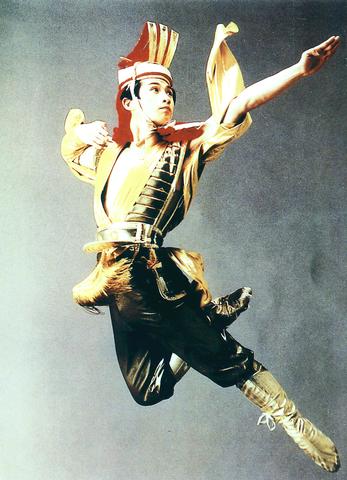He is one of the youngest artistic directors of a major dance company in China. Huang Dou Dou (
Shouting from the darkened auditorium, Huang was making last minute adjustments to the show yesterday, after a difficult trip from Hong Kong.
"We almost didn't make it," he said. Two other performers from China failed to make it for performances in the Formosa International Arts Festival due to "visa problems," so Huang's presence has been organized by Taipei Arts International Association independently of the festival.

PHOTO: TAIA
Huang said that getting things happening in Taipei was equally problematic. "I guess we have different ways of doing things," he said, before getting back to sorting out stage positions.
The Shanghai Dance Company was founded in 1979 to perform folk and modern dance works and has received considerable acclaim for its creativeness with its material. Huang, who took over as artistic director at age 23, continues this tradition of innovation and the emphasis on youth. Huang brings with him to the troupe a background in martial arts and traditional dance that has made him particularly adept as an interpreter of the new language of Chinese dance.
"Of course, for young people like myself and my dancers, there are many western things that exercise enormous appeal," he said. "Many dancers I know have opted for developing as `contemporary' dancers, Technically, they are the equals of white or black dancers, but spiritually, it is very difficult for them to make any breakthrough. This is why I build my own dance on a Chinese foundation."
Huang emphasized that he is not trying to follow in the wake of traditional opera, but to create a new language, something that can be termed "contemporary Chinese dance."
"Take something like Tang poetry," Huang said. "In the modern world, you can't bring people to an appreciation of it simply by reciting it to them. There is a gap of understanding. The same is true of traditional dance. You must find a new language to express it to them."
Audiences can be in little doubt about the "Chineseness" of the show, especially when faced with dances based around topics such as the terracotta soldiers of Xian or on movement of black and white pieces on a Go chessboard. The conscious exoticism or use of stereotypical images might strike a jarring note for some, but Huang sees this as an important way of bringing audiences to an understanding of "what is Chinese."
Huang's own dancing has a virility and strength that is extremely attractive, and the show brims over with athleticism. The performance has an operatic grandeur even though Huang said that the show had already been stripped back to bare essentials. "After all this is an arts festival," he said, "so we focused on the dance elements. Audiences in Shanghai generally demand more in the way of spectacle."
For Taipei audiences, used to a diet of minimalist dance, there is spectacle enough, and the ostentatious colored lights and smoke machine might come over as a tad passe.
Whatever the outward form takes, with Huang's current status within the Chinese dance world at present, he has good claim to represent some of the trends in dance that are emerging with a new generation of dancers who are seeking new idioms in which to express themselves.

Following the shock complete failure of all the recall votes against Chinese Nationalist Party (KMT) lawmakers on July 26, pan-blue supporters and the Chinese Communist Party (CCP) were giddy with victory. A notable exception was KMT Chairman Eric Chu (朱立倫), who knew better. At a press conference on July 29, he bowed deeply in gratitude to the voters and said the recalls were “not about which party won or lost, but were a great victory for the Taiwanese voters.” The entire recall process was a disaster for both the KMT and the Democratic Progressive Party (DPP). The only bright spot for

Water management is one of the most powerful forces shaping modern Taiwan’s landscapes and politics. Many of Taiwan’s township and county boundaries are defined by watersheds. The current course of the mighty Jhuoshuei River (濁水溪) was largely established by Japanese embankment building during the 1918-1923 period. Taoyuan is dotted with ponds constructed by settlers from China during the Qing period. Countless local civic actions have been driven by opposition to water projects. Last week something like 2,600mm of rain fell on southern Taiwan in seven days, peaking at over 2,800mm in Duona (多納) in Kaohsiung’s Maolin District (茂林), according to

Aug. 11 to Aug. 17 Those who never heard of architect Hsiu Tse-lan (修澤蘭) must have seen her work — on the reverse of the NT$100 bill is the Yangmingshan Zhongshan Hall (陽明山中山樓). Then-president Chiang Kai-shek (蔣介石) reportedly hand-picked her for the job and gave her just 13 months to complete it in time for the centennial of Republic of China founder Sun Yat-sen’s birth on Nov. 12, 1966. Another landmark project is Garden City (花園新城) in New Taipei City’s Sindian District (新店) — Taiwan’s first mountainside planned community, which Hsiu initiated in 1968. She was involved in every stage, from selecting

The great number of islands that make up the Penghu archipelago make it a fascinating place to come back and explore again and again. On your next trip to Penghu, why not get off the beaten path and explore a lesser-traveled outlying island? Jibei Island (吉貝嶼) in Baisha Township (白沙鄉) is a popular destination for its long white sand beach and water activities. However, three other permanently inhabited islands in the township put a unique spin on the traditional Penghu charm, making them great destinations for the curious tourist: Yuanbeiyu (員貝嶼), Niaoyu (鳥嶼) and Dacangyu (大倉嶼). YUANBEIYU Citou Wharf (岐頭碼頭) connects the mainland